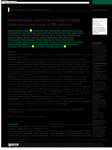Subcutaneous cladribine to treat multiple sclerosis: experience in 208 patients
| dc.contributor.author | Allen-Philbey, K | |
| dc.contributor.author | De Trane, S | |
| dc.contributor.author | Mao, Z | |
| dc.contributor.author | Álvarez-González, C | |
| dc.contributor.author | Mathews, J | |
| dc.contributor.author | MacDougall, A | |
| dc.contributor.author | Stennett, A | |
| dc.contributor.author | Zhou, X | |
| dc.contributor.author | Yildiz, O | |
| dc.contributor.author | Adams, A | |
| dc.contributor.author | Bianchi, L | |
| dc.contributor.author | Blain, C | |
| dc.contributor.author | Chapman, C | |
| dc.contributor.author | Chung, K | |
| dc.contributor.author | Constantinescu, CS | |
| dc.contributor.author | Dalton, C | |
| dc.contributor.author | Farrell, RA | |
| dc.contributor.author | Fisniku, L | |
| dc.contributor.author | Ford, H | |
| dc.contributor.author | Gran, B | |
| dc.contributor.author | Hobart, J | |
| dc.contributor.author | Khaleeli, Z | |
| dc.contributor.author | Mattoscio, M | |
| dc.contributor.author | Pavitt, S | |
| dc.contributor.author | Pearson, O | |
| dc.contributor.author | Peruzzotti-Jametti, L | |
| dc.contributor.author | Scalfari, A | |
| dc.contributor.author | Sharrack, B | |
| dc.contributor.author | Silber, E | |
| dc.contributor.author | Tallantyre, EC | |
| dc.contributor.author | Webb, S | |
| dc.contributor.author | Turner, BP | |
| dc.contributor.author | Marta, M | |
| dc.contributor.author | Gnanapavan, S | |
| dc.contributor.author | Juliusson, G | |
| dc.contributor.author | Giovannoni, G | |
| dc.contributor.author | Baker, D | |
| dc.contributor.author | Schmierer, K | |
| dc.date.accessioned | 2022-02-15T14:17:37Z | |
| dc.date.available | 2022-02-15T14:17:37Z | |
| dc.date.issued | 2021-01-01 | |
| dc.identifier.issn | 1756-2856 | |
| dc.identifier.issn | 1756-2864 | |
| dc.identifier.other | 175628642110576 | |
| dc.identifier.uri | http://hdl.handle.net/10026.1/18795 | |
| dc.description.abstract |
Objective: To report on safety and effectiveness of subcutaneous cladribine (Litak®) in multiple sclerosis (MS) patients. Methods: Litak® was offered to MS-patients irrespective of disease course. Litak® 10 mg was administered for 3–4 days during week 1. Based on lymphocyte count at week 4, patients received another 0–3 doses at week 5. A second course was administered 11 months later. Follow-up included adverse events, relapses, expanded disability status scale (EDSS), 9-hole-peg and Timed-25-foot-walking tests, no-evidence-of-disease-activity (NEDA), no-evidence-of-progression-or-active-disease (NEPAD), MRI, cerebrospinal fluid (CSF) neurofilament light chain (NfL), and lymphocyte counts. Results: In all, 208 patients received at least one course of treatment. Age at baseline was 44 (17–72) years and EDSS 0–8.5. Cladribine was generally well tolerated. One myocardial infarction, one breast cancer, and three severe skin reactions occurred without long-term sequelae. Two patients died (one pneumonia, one encephalitis). Lymphopenia grade 3 occurred in 5% and grade 4 in 0.5%. In 94 out of 116 pwMS with baseline and follow-up (BaFU) data after two treatment courses, EDSS remained stable or improved. At 18 months, 64% of patients with relapsing MS and BaFU data ( n = 39) had NEDA. At 19 months, 62% of patients with progressive MS and BaFU data ( n = 13) had NEPAD. Of n = 13 patients whose CSF-NfL at baseline was elevated, 77% were normalised within 12 months. Conclusions: Litak® was well tolerated. Effectiveness in relapsing MS appeared similar to cladribine tablets and was encouraging in progressive MS. Our data suggest cladribine may be safe and effective in MS-patients irrespective of their disease stage. | |
| dc.format.extent | 175628642110576-175628642110576 | |
| dc.format.medium | Electronic-eCollection | |
| dc.language | en | |
| dc.language.iso | en | |
| dc.publisher | SAGE Publications | |
| dc.subject | cladribine | |
| dc.subject | disease-modifying treatment | |
| dc.subject | multiple sclerosis | |
| dc.subject | NEDA | |
| dc.subject | NEPAD | |
| dc.subject | treatment access | |
| dc.title | Subcutaneous cladribine to treat multiple sclerosis: experience in 208 patients | |
| dc.type | journal-article | |
| dc.type | Journal Article | |
| plymouth.author-url | https://www.webofscience.com/api/gateway?GWVersion=2&SrcApp=PARTNER_APP&SrcAuth=LinksAMR&KeyUT=WOS:000726784900001&DestLinkType=FullRecord&DestApp=ALL_WOS&UsrCustomerID=11bb513d99f797142bcfeffcc58ea008 | |
| plymouth.volume | 14 | |
| plymouth.publication-status | Published | |
| plymouth.journal | Therapeutic Advances in Neurological Disorders | |
| dc.identifier.doi | 10.1177/17562864211057661 | |
| plymouth.organisational-group | /Plymouth | |
| plymouth.organisational-group | /Plymouth/Faculty of Health | |
| plymouth.organisational-group | /Plymouth/Faculty of Health/Peninsula Medical School | |
| plymouth.organisational-group | /Plymouth/REF 2021 Researchers by UoA | |
| plymouth.organisational-group | /Plymouth/REF 2021 Researchers by UoA/UoA03 Allied Health Professions, Dentistry, Nursing and Pharmacy | |
| plymouth.organisational-group | /Plymouth/Research Groups | |
| plymouth.organisational-group | /Plymouth/Research Groups/Institute of Translational and Stratified Medicine (ITSMED) | |
| plymouth.organisational-group | /Plymouth/Research Groups/Institute of Translational and Stratified Medicine (ITSMED)/CCT&PS | |
| plymouth.organisational-group | /Plymouth/Users by role | |
| plymouth.organisational-group | /Plymouth/Users by role/Academics | |
| dc.publisher.place | England | |
| dcterms.dateAccepted | 2021-10-15 | |
| dc.rights.embargodate | 2022-2-16 | |
| dc.identifier.eissn | 1756-2864 | |
| dc.rights.embargoperiod | Not known | |
| rioxxterms.versionofrecord | 10.1177/17562864211057661 | |
| rioxxterms.licenseref.uri | http://www.rioxx.net/licenses/all-rights-reserved | |
| rioxxterms.licenseref.startdate | 2021-01-01 | |
| rioxxterms.type | Journal Article/Review |


